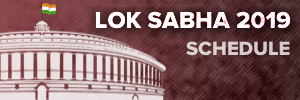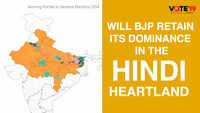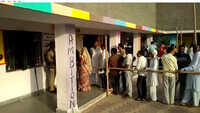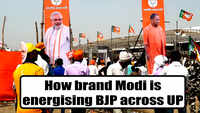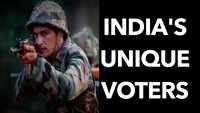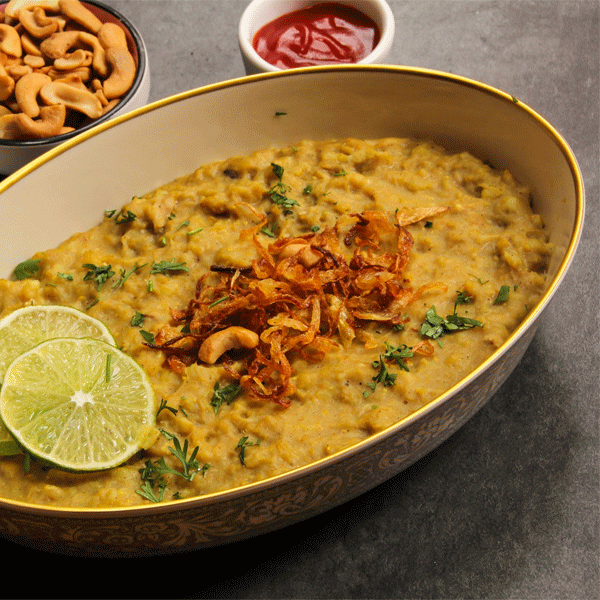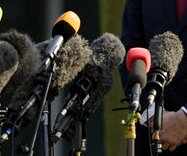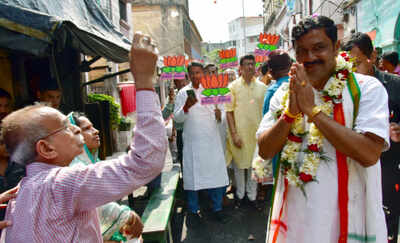
Highlights
20+. That's the number from West Bengal that BJP leaders- Narendra Modi to Amit Shah- have been talking about. Aiming too high, in a state where the party has all of two MPs currently? (One of the two being Darjeeling, where the issues and overall political rhetoric are starkly different from that in the plains)
The only success story of the saffron party, since it parted ways with Trinamool to fight elections on its own in the state, has been the surprise victory of Babul Supriyo from Asansol in 2014.
Worth mentioning, West Bengal did not figure so prominently in BJP's scheme of things in 2014. Narendra Modi, the party's prime ministerial candidate addressed just a couple of rallies in the state, one being in Asansol. And 'Modi wave' was at its peak. The factors combined well to hand Babul Supriyo, a complete rookie, a victory over the seasoned Dola Sen of TMC.
Cut to 2019. Sensing a groundswell in its political capital, frontline BJP leaders are addressing 21 major rallies this time, and hope to reap a good harvest.
20+ or not, the BJP can certainly hope for an improved showing. It needs to retain Asansol to prove that 2014 was no freak result. (Yes, Modi addressed a rally here this time too!) Babul is pitted against TMC's actor-turned-politician Moonmoon Sen. She won handsomely from Bankura in 2014, but the TMC is keen to reverse the Asansol humiliation by fielding a 'winner.' And Mamata's 'star' gambits, more often than not, have paid off.
The party also needs to make forays into newer territories. An odd seat or two in the TMC citadels of greater or metropolitan Kolkata is just the kind of coup it will seek, to be taken as a credible opposition force to the mighty Trinamool.
And Kolkata (N) is one seat where the BJP can fancy its chances, where Rahul Sinha, a former state party chief, is up against the veteran Sudip Bandyopadhyay of TMC, a 4-time MP and 4-time MLA.
 (Source: Wikipedia)
(Source: Wikipedia)
Analysis of poll data from the past two Lok Sabha elections makes the contest rather interesting. In 2009, Tathagata Roy of BJP finished third, polling just 4.22% votes (behind Bandyopadhyay with 52.50% and Md Salim of CPM with over 40%).
But 2014 sprang a surprise, when BJP's vote share shot up to 25.88%, well clear of CPM (20.50%) and Congress (13.68%).
This time, even a moderate swing from the CPM and Congress kitties could close BJP's gap with Trinamool's 35.94% in 2014.
Just how likely is that? Demography, political issues, pro- and anti-incumbency, and the candidates themselves- everything needs to be factored in to gauge that.
Apart from native Bengalis, Jorasanko, Manicktala and Shyampukur assembly segments have a significant concentration of Hindi-speaking population, comprising business communities like Marwaris, and settlers from Bihar, UP and other northern states. A major chunk of these voters remained Congress loyalists, even when the CPM ruled the state with an iron fist. However it was in these pockets that the BJP, another national party, marked its first presence in the city, during the years of its phenomenal growth in north India.
Will the political vibes in their states of their origin resonate with the immigrant population here? More so, since this is a national election? (Remember, BJP is perceived as a Hindi heartland party)
The area also houses Posta-Burrabazar, the largest wholesale market in Eastern India. And a good fraction of transactions happen in hard cash. DeMo blues, GST... will the business community carry some of those heartburns to the EVMs?
The Chowrangee and Entally assembly seats in the business district of central Kolkata are an even more cosmopolitan mix, with a sizeable chunk of minority (Christian and Muslim) voters. These too were traditional Congress strongholds, where the Trinamool now holds sway. Chowrangee has sent stalwarts like Bidhan Ch Roy and Siddhartha Shankar Ray to the state assembly. No party, even the CPM in its prime, has been able to dent Chowrangee, since 1951.
Although the state is not known to vote on caste and religious lines, minorty votes can still tilt the balance, one way or the other. Will the anti-BJP votes concentrate in one pocket, or trifurcate between Congreess, CPM and TMC? How will any disenchantment with the incumbent government, either at the Centre or in the state, affect sentiments? And, which way will the first-time voters lean?
The 'weight' a candidate carries is also important, when it comes to voter sentiment. Trinamool has played its best bet by fielding Sudip Bandyopadhyay from Kolkata (N). But of late he has been embroiled in controversy, even doing time for alleged involvement in the Rose Valley money laundering scam. Has the blot cost him any poliitcal equity? What will be on the minds of the voters when they step out on May 19?
Rahul Sinha on the other hand, has been a frontline name in the state BJP. But his scoreline in elections so far reads an inauspicious 0-3. He contested from Jorasanko in the 2016 assembly elections, and was expected to gain from a strong anti-govt sentiment following the Vivekananda Road flyover collapse (within the constituency), just months before the polls. But he finished second to TMC's Smita Bakshi.
CPM's Kaninika Bose Ghosh and Congress' Syed Shahid Imam are relatively unknown faces, and political 'lightweights' compared to Bandyopadhyay and Sinha. How much of the 'floating votes' will they corner? Can they even secure the 'committed vote bank?' If not, into which kitty will these votes flow? That might make all the difference.
The only success story of the saffron party, since it parted ways with Trinamool to fight elections on its own in the state, has been the surprise victory of Babul Supriyo from Asansol in 2014.
Worth mentioning, West Bengal did not figure so prominently in BJP's scheme of things in 2014. Narendra Modi, the party's prime ministerial candidate addressed just a couple of rallies in the state, one being in Asansol. And 'Modi wave' was at its peak. The factors combined well to hand Babul Supriyo, a complete rookie, a victory over the seasoned Dola Sen of TMC.
Cut to 2019. Sensing a groundswell in its political capital, frontline BJP leaders are addressing 21 major rallies this time, and hope to reap a good harvest.
20+ or not, the BJP can certainly hope for an improved showing. It needs to retain Asansol to prove that 2014 was no freak result. (Yes, Modi addressed a rally here this time too!) Babul is pitted against TMC's actor-turned-politician Moonmoon Sen. She won handsomely from Bankura in 2014, but the TMC is keen to reverse the Asansol humiliation by fielding a 'winner.' And Mamata's 'star' gambits, more often than not, have paid off.
The party also needs to make forays into newer territories. An odd seat or two in the TMC citadels of greater or metropolitan Kolkata is just the kind of coup it will seek, to be taken as a credible opposition force to the mighty Trinamool.
And Kolkata (N) is one seat where the BJP can fancy its chances, where Rahul Sinha, a former state party chief, is up against the veteran Sudip Bandyopadhyay of TMC, a 4-time MP and 4-time MLA.

Analysis of poll data from the past two Lok Sabha elections makes the contest rather interesting. In 2009, Tathagata Roy of BJP finished third, polling just 4.22% votes (behind Bandyopadhyay with 52.50% and Md Salim of CPM with over 40%).
But 2014 sprang a surprise, when BJP's vote share shot up to 25.88%, well clear of CPM (20.50%) and Congress (13.68%).
This time, even a moderate swing from the CPM and Congress kitties could close BJP's gap with Trinamool's 35.94% in 2014.
Just how likely is that? Demography, political issues, pro- and anti-incumbency, and the candidates themselves- everything needs to be factored in to gauge that.
Apart from native Bengalis, Jorasanko, Manicktala and Shyampukur assembly segments have a significant concentration of Hindi-speaking population, comprising business communities like Marwaris, and settlers from Bihar, UP and other northern states. A major chunk of these voters remained Congress loyalists, even when the CPM ruled the state with an iron fist. However it was in these pockets that the BJP, another national party, marked its first presence in the city, during the years of its phenomenal growth in north India.
Will the political vibes in their states of their origin resonate with the immigrant population here? More so, since this is a national election? (Remember, BJP is perceived as a Hindi heartland party)
The area also houses Posta-Burrabazar, the largest wholesale market in Eastern India. And a good fraction of transactions happen in hard cash. DeMo blues, GST... will the business community carry some of those heartburns to the EVMs?
The Chowrangee and Entally assembly seats in the business district of central Kolkata are an even more cosmopolitan mix, with a sizeable chunk of minority (Christian and Muslim) voters. These too were traditional Congress strongholds, where the Trinamool now holds sway. Chowrangee has sent stalwarts like Bidhan Ch Roy and Siddhartha Shankar Ray to the state assembly. No party, even the CPM in its prime, has been able to dent Chowrangee, since 1951.
Although the state is not known to vote on caste and religious lines, minorty votes can still tilt the balance, one way or the other. Will the anti-BJP votes concentrate in one pocket, or trifurcate between Congreess, CPM and TMC? How will any disenchantment with the incumbent government, either at the Centre or in the state, affect sentiments? And, which way will the first-time voters lean?
The 'weight' a candidate carries is also important, when it comes to voter sentiment. Trinamool has played its best bet by fielding Sudip Bandyopadhyay from Kolkata (N). But of late he has been embroiled in controversy, even doing time for alleged involvement in the Rose Valley money laundering scam. Has the blot cost him any poliitcal equity? What will be on the minds of the voters when they step out on May 19?
Rahul Sinha on the other hand, has been a frontline name in the state BJP. But his scoreline in elections so far reads an inauspicious 0-3. He contested from Jorasanko in the 2016 assembly elections, and was expected to gain from a strong anti-govt sentiment following the Vivekananda Road flyover collapse (within the constituency), just months before the polls. But he finished second to TMC's Smita Bakshi.
CPM's Kaninika Bose Ghosh and Congress' Syed Shahid Imam are relatively unknown faces, and political 'lightweights' compared to Bandyopadhyay and Sinha. How much of the 'floating votes' will they corner? Can they even secure the 'committed vote bank?' If not, into which kitty will these votes flow? That might make all the difference.
Download The Times of India News App for Latest Elections News.
#ElectionsWithTimes
more from times of india news
Get the app

